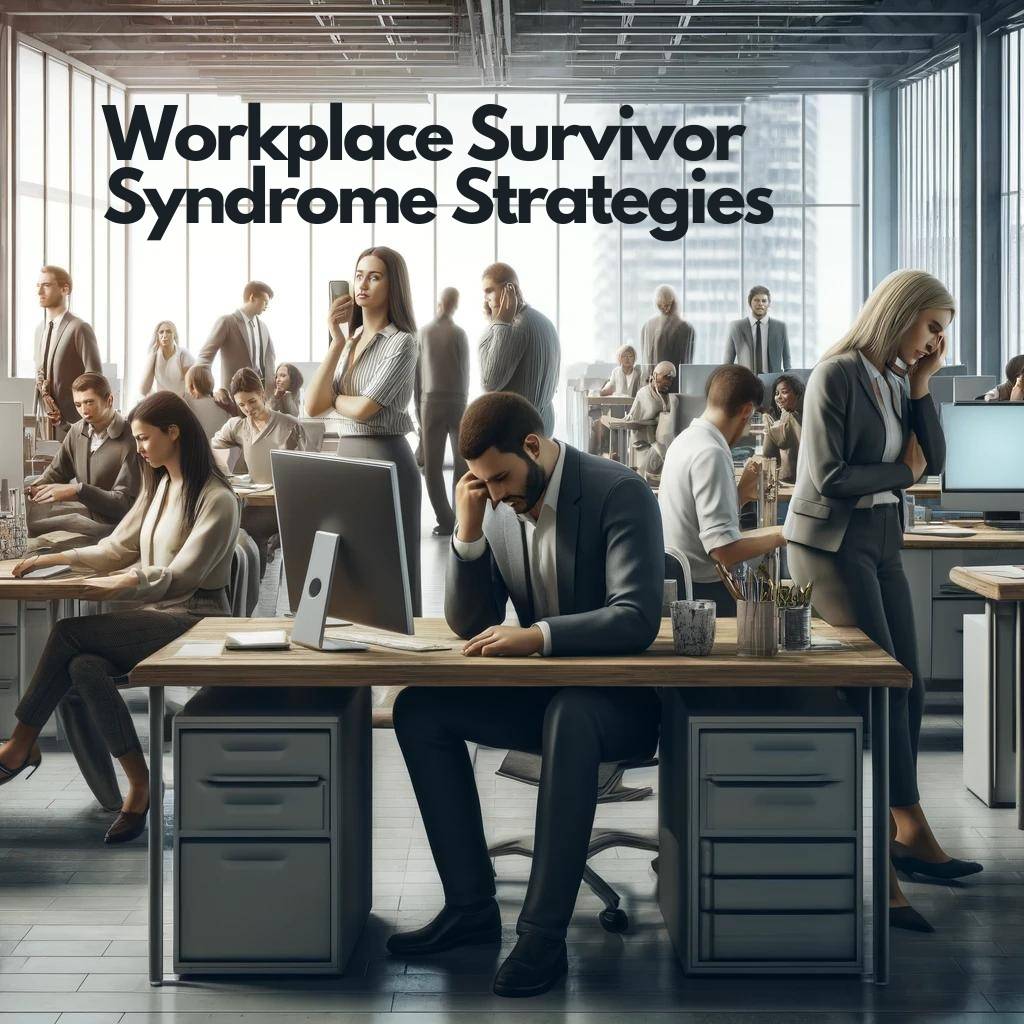
Workplace Survivor Syndrome: Navigating the Storm of Corporate Recovery
Workplace Survivor Syndrome: it’s a phenomenon many might not have heard of, yet it impacts numerous individuals across various industries. When a company goes through layoffs, those who remain—often termed “survivors”—can experience a complex mix of relief, guilt, and stress. The syndrome is not just a buzzword but a significant occupational psychological phenomenon that can affect mental health and job performance significantly.
The Reality of the Syndrome: As someone who has navigated through multiple corporate restructurings, the emotional aftermath for the survivors is real and palpable. There’s a distinct atmosphere of uncertainty that permeates the workplace. It’s like walking through a familiar forest that has partially burned down; you recognize the landscape, but it’s fundamentally changed.

Recognizing the Symptoms
Survivor syndrome manifests through various symptoms:
- Guilt: Feeling unworthy or guilty for keeping your job while peers were laid off.
- Anxiety: Persistent worries about future layoffs, affecting daily productivity and mental peace.
- Burnout: Increased workload with fewer resources often leads to stress and burnout.
- Detachment: Emotional distancing as a defense mechanism against further psychological trauma.
These symptoms aren’t just numbers on a paper; they are real, experienced daily by real people. Understanding them is the first step towards effective management.
Coping Strategies for Workplace Survivor Syndrome
Dealing with Workplace Survivor Syndrome requires a mix of personal resilience and organizational support. Here’s how one can effectively cope:
Personal Coping Strategies
- Self-Reflection: Take time to understand and process your feelings. Writing a journal or talking to a trusted friend can help in articulating these emotions.
- Professional Help: Don’t hesitate to seek help from a mental health professional. Therapy can provide valuable tools to manage stress, anxiety, and guilt.
- Setting Boundaries: Learn to say no. Overworking to compensate for a reduced workforce will only lead to burnout.
- Mindfulness and Relaxation Techniques: Engage in activities like yoga, meditation, or even simple breathing exercises to alleviate stress.
Organizational Support Strategies
Organizations play a crucial role in aiding employees to cope with the syndrome. Here are a few measures that can be implemented:
- Transparent Communication: Regular updates about the company’s status and future plans can reduce uncertainty and anxiety among employees.
- Professional Counseling Access: Providing access to counseling services can help employees deal with their emotional turmoil.
- Workload Management: Ensuring that the workload is fairly distributed and manageable is crucial in preventing burnout.
- Building a Supportive Culture: Promoting a culture where employees feel valued and supported can enhance overall morale and productivity.

Incorporating metaphors, the journey through coping with survivor syndrome is akin to navigating a ship through stormy seas. The waves of guilt and anxiety might threaten to overturn the vessel, but with a steady hand and clear direction, one can reach calmer waters.
The Table of Coping Strategies
Below, you’ll find a table summarizing these coping strategies:
| Type | Strategy | Description |
|---|---|---|
| Personal | Self-Reflection | Reflect on and process personal feelings. |
| Personal | Professional Help | Seek counseling to manage emotional and mental challenges. |
| Personal | Setting Boundaries | Limit workload to prevent burnout. |
| Personal | Mindfulness and Relaxation | Use techniques to reduce stress. |
| Organizational | Transparent Communication | Keep employees informed about company plans. |
| Organizational | Professional Counseling Access | Provide access to mental health services. |
| Organizational | Workload Management | Ensure fair distribution of work. |
| Organizational | Supportive Culture | Foster a positive, supportive workplace environment. |
Broader Implications of Workplace Survivor Syndrome in Different Industries
Workplace Survivor Syndrome isn’t confined to one type of business or industry; its repercussions are felt across the board, from healthcare to technology, each with its unique challenges and outcomes.
Impact on Various Industries
- Healthcare: In the high-stress environment of healthcare, survivor syndrome can exacerbate the existing pressures faced by medical staff, leading to increased errors and lower quality of patient care.
- Technology: Tech companies often undergo rapid changes and restructuring. Survivor syndrome here can lead to a decline in innovation as employees focus more on job security than on creativity.
- Manufacturing: The impact in manufacturing can be seen in decreased productivity and quality as workers may feel demotivated and less engaged.
- Education: Educators facing this syndrome may experience a decline in their teaching effectiveness, impacting student performance and overall educational quality.
Each industry faces its specific set of stressors that can amplify the effects of survivor syndrome, affecting not just the individual employees but the overall industry performance.
Counterpoints and Debate
While the negative effects of survivor syndrome are well-documented, some argue that experiencing such changes can lead to positive outcomes:
- Resilience Building: Employees might develop greater resilience and adaptability.
- Efficiency Improvements: Organizations may become more efficient as they are forced to rethink operations and streamline processes.
This duality presents a complex picture: while the syndrome can be debilitating, it also offers opportunities for growth and improvement.

Example with Data: Manufacturing Industry’s Response
To illustrate, consider the following data from a study on manufacturing plants that experienced layoffs:
- Productivity: Post-layoff, 60% of the plants reported a temporary dip in productivity, which normalized after about six months.
- Employee Sentiment: Surveys indicated a 30% increase in job insecurity among survivors, yet 40% reported feeling more valued after seeing new efficiencies in place.
Such statistics highlight the nuanced nature of survivor syndrome’s impact: it’s a catalyst for both challenges and potential positive transformations.
Long-term Outlook and Preventative Measures for Workplace Survivor Syndrome
The long-term management of Workplace Survivor Syndrome involves not only addressing the immediate impacts but also setting in place strategies to prevent its recurrence. Understanding the potential future scenarios helps organizations and individuals prepare and mitigate the effects more effectively.
Future Outlook
- Normalization of Feelings: Over time, survivors often adapt to the new norm, with feelings of guilt and anxiety gradually subsiding. However, without proper support, these feelings can evolve into chronic stress or disengagement.
- Organizational Learning: Companies that effectively navigate through layoffs by providing adequate support and communication often emerge stronger, with a more committed and resilient workforce.
Preventative Strategies
Organizations can take proactive steps to minimize the impact of future layoffs and the prevalence of survivor syndrome:
- Pre-Layoff Planning: Engaging in thorough planning and consideration of alternatives before deciding on layoffs can help minimize their number and impact.
- Enhanced Communication: Transparent, frequent communication before, during, and after layoffs helps reduce uncertainty and builds trust.
- Employee Support Programs: Implementing support programs such as career coaching, training, and mental health resources aids in quicker emotional and professional recovery.
- Culture of Engagement: Cultivating a culture that values each employee’s contributions and fosters a sense of security and belonging can buffer the negative impacts of organizational changes.
An Example of Effective Strategy Implementation
Consider a tech company that introduced a ‘Recovery and Innovation Program’ post-layoff, which included:
- Skill Development Workshops: To enhance employee capabilities and adaptability.
- Regular Feedback Sessions: To maintain open lines of communication and address any ongoing concerns.
- Innovation Challenges: To encourage creative thinking and engagement, despite recent layoffs.
Such initiatives not only aid in recovery but also propel the organization forward by harnessing the creative potential of the remaining workforce.

Presentation of Data and Insights
Below is a diagram illustrating the impact of such preventative measures on employee morale and productivity over a 12-month period:
- The graph shows a significant improvement in employee morale and productivity levels, clearly correlating with the implementation of the Recovery and Innovation Program.
Key Takeaways and Final Thoughts on Workplace Survivor Syndrome
In closing, Workplace Survivor Syndrome is a multifaceted issue that requires a nuanced approach for effective management and prevention. It’s crucial for organizations to recognize the symptoms early and implement robust strategies to support their workforce.
Key Takeaways
- Recognize the Symptoms Early: Early recognition allows for timely intervention, which can mitigate the negative effects of survivor syndrome.
- Comprehensive Support Systems: Effective coping mechanisms, both at personal and organizational levels, are critical. This includes access to mental health resources, transparent communication, and workload management.
- Foster a Resilient Organizational Culture: A culture that promotes resilience, values employee contributions, and focuses on continuous improvement can enhance the overall health of the organization and its employees.
- Continuous Improvement and Learning: Organizations should view the challenges associated with layoffs as opportunities for learning and improving operational efficiency and employee well-being.
Final Thoughts
Managing Workplace Survivor Syndrome is not just about recovery; it’s about turning a challenging situation into an opportunity for growth and improvement. Organizations that proactively address the emotional and professional needs of their employees not only enhance their well-being but also position themselves for greater resilience and success in the future.
Reflecting on the Discussion
This discussion serves as a comprehensive guide for understanding and managing Workplace Survivor Syndrome. By considering the insights and strategies presented, organizations can better prepare to support their employees through challenging times, leading to a healthier, more productive workforce.


